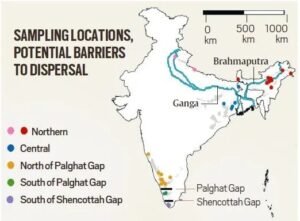GS Paper 3: Environment |
Why in the News?
Recently, researchers from Bengaluru’s National Centre for Biological Sciences (NCBS) and the Indian Institute of Science (IISc) made an important discovery about Indian elephants.
Their study revealed that elephants migrated southward over millennia, resulting in a gradual loss of genetic diversity with each migration.
Key Findings on Indian Elephant Migration and Genetic Diversity
- Migration from North to South:
Indian elephants have progressively migrated from the north to the south over thousands of years. This movement led to a decline in genetic diversity, with the southern populations showing reduced genetic strength compared to northern populations. - Five Genetically Distinct Populations:
The researchers identified five distinct elephant populations across India:
- A northern population along the foothills of the Himalayas, stretching from the Northwest to the Northeast.
- A central population located in parts of central India.
- Three southern populations are found in Tamil Nadu and Kerala, south of the Shencottah Gap.
- Southernmost Population and Genetic Diversity:
The elephant population located south of the Shencottah Gap has the lowest genetic diversity, making it especially vulnerable. With fewer than 150 elephants, this population is at greater risk of extinction due to its isolation and reduced genetic variation. - Historical Divergence of Populations:
The study showed that the northern elephant population separated from the others around 70,000 years ago. Elephants in central India diverged approximately 50,000 years ago, while the three southern populations became distinct about 20,000 years ago. - Serial Founder Effect and Inbreeding Risk:
As elephants migrated south, the smaller population sizes led to a phenomenon known as the serial founder effect. This increases the risk of inbreeding, where harmful genetic traits have a higher chance of being passed down to future generations. - Southern Barrier:
The study also found that the Shencottah Gap acted as a natural barrier, further dividing the southern elephant populations. Previously, the Palghat Gap was thought to be the only barrier in the Western Ghats, but this research uncovered another significant division. - Central and Northern Populations:
Elephants in central India are found between southwest West Bengal and eastern Maharashtra, forming a distinct population. Northern elephants, located in the Northwest (Uttarakhand, Uttar Pradesh) and Northeast (Assam, Arunachal Pradesh), are separated by the Ganga and Brahmaputra rivers but were historically connected. - Importance of Habitat Connectivity:
The study highlights the importance of maintaining habitat connectivity, particularly in the Western Ghats, where infrastructure development has disrupted the flow of genes between elephant populations. This connectivity is crucial for preserving genetic diversity and reducing the risk of extinction.
Explore our Books: https://apnipathshala.com/product-category/books/
Explore Our test Series: https://tests.apnipathshala.com/








